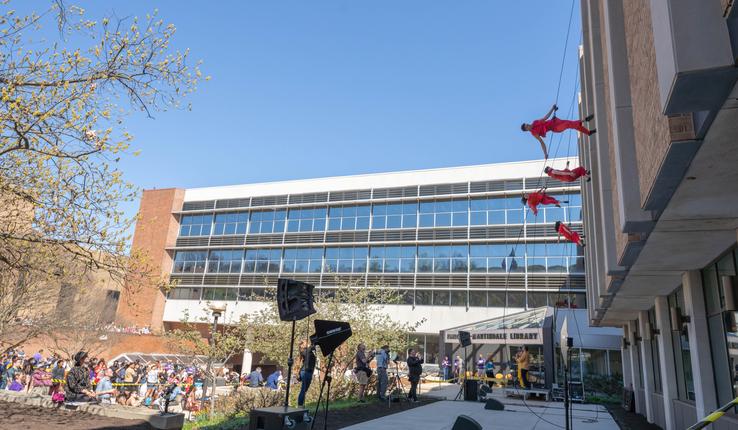More than 350 people participated in the workshops, run by LTS’s instructional technology team and its distance education and online learning groups. Afterward, the recordings had 570 views.
LTS also rolled out resources to help faculty, students and staff alike to make the quick transition to online teaching and learning:
Meanwhile, as the LTS technology teams were busy bolstering infrastructure, software licensing and information security, the LTS Help Desk and client services teams got ready for an expected uptick in help requests. Reihman said the Help Desk quickly deepened their familiarity with Lehigh’s instructional tools and practices, because they knew they were going to be fielding more questions of that type, in addition to more complex questions from faculty and students, and would likely be on calls longer. They also knew they would be working with some faculty who faced challenging and unique situations, such as delivering exams online for the first time or leading labs, studios and performance courses.
If the Help Desk was unable to address an issue, questions were passed on to the instructional technology team, to a librarian, or to Reihman. “Our instructional technologists began focusing more on the tough cases, those that had a unique twist, that didn't quite fit our standard recommendations,” he said.
Surveying Faculty
To gauge readiness, Reihman surveyed faculty members about how confident they were about teaching remotely. Before the shift to remote learning, about 40 percent of faculty said they already felt confident, because they had strong technical skills or had previously taught remotely, while 35 percent were in the midrange level. Reihman said 25 percent reported low confidence.
By the end of the first week of remote learning, however, faculty confidence surged to 68 percent, and another 30 percent rose to midrange, meaning they were okay with the basics but still looking for some help with more advanced approaches. Only 2 percent still reported low confidence in teaching online, noting that they could still use help with the basics.
“It's a truly remarkable transformation,” Reihman noted. “With some guidance, a lot of hard work, and some experience, you realize you can do a lot more than you thought you could do online, that you really can connect with your students, you really can instruct and help and guide and have good discussions.
“Sometimes, when you're in a conversation, the technology between you and your students kind of fades away, and you feel like you're right there with them,” said Reihman, who also teaches a course on Philosophy and Technology. “As long as that continues to happen, people can still feel really connected.”
Reihman said his students have reported a broad range of experiences with their online classes. Some say, this is going amazingly well. Others say courses got off to a rocky start but that faculty and students gradually figured things out.
“Some students have pointed out some real positives. With a recorded lecture, you can go back and watch it again and again,” he said. “Some have felt like the faculty have made such an extra effort to connect with them that they feel really well taken care of.”
Reihman acknowledged, however, that “it's not all roses.” Some students report that there’s less activity in some online environments. “In some cases, they say it feels like it's more of a passive reception of content, and that may be something that faculty members are still working out at this point,” he said. “Some students miss the patterns of going to class and the social experience of what it means to be a university student, learning together. They miss their faculty and miss studying together in our libraries.”
Reihman said a subset of students face additional challenges—perhaps they don't have the technology to connect to classes online or are now back home in a different time zone, which throws off their class times.
LTS worked with the Dean of Students and the Office of Diversity, Inclusion, and Equity to identify and then meet students’ technology needs. The CITL encouraged faculty members to survey their students to assess the additional challenges they might be facing. In response to students now back home in a different time zone, for example, faculty members can record their Zoom sessions and post them as recordings for those students to be able to access later. He said faculty members also are creating extra office hours that might be more time zone friendly.
Provost Pat Farrell and the Registrar’s Office directed faculty to stick with their scheduled class times if holding live sessions to avoid “scheduling chaos” for students. Some faculty members scheduled asynchronous work, so that students can log into recorded classes when more convenient for them.
“We're all going to come out of this different, in some way or another,” Reihman said about the pandemic’s impact on teaching and learning. “The key is to be as thoughtful as we can about what we want to retain from this and what we don't.”
In his experience, he said, faculty members who teach online for the first time almost always undergo some realization that there are parts of online teaching that are really good and that they can incorporate into their face-to-face classes. He said they also have a heightened awareness of the value of being face-to-face and will plan to make even better use of precious time spent physically together. Additionally, he said, faculty, students and staff are developing a deepened understanding of what strategies work best in different situations and are becoming more proficient users of various technologies for effective meetings, collaboration and classroom conversations.
“It's too early to make any predictions,” Reihman said. “I think faculty members will just be happy for things to get back to normal for a little while.” But, he added, “Once Lehigh’s creative faculty have these tools in hand, they're going to do all sorts of wonderful things that I don't think we can even imagine yet.”





